Small closets don’t have to mean fashion chaos. With the right strategies, even the tiniest storage space can hold more clothes than you thought possible. These proven organization ideas will help you create a functional wardrobe system that saves time and reduces stress.
Whether you’re dealing with a narrow reach-in closet or a cramped walk-in space, these solutions work for real people in real homes. No expensive renovations required.
Why Small Closet Organization Matters
A disorganized small closet wastes precious time every morning. Studies show the average person spends 12 minutes daily searching for clothes. That adds up to 73 hours per year of lost time.
Poor closet organization also leads to buying duplicate items you already own but can’t find. This creates unnecessary spending and more clutter in an already tight space.
Good organization systems make small spaces feel larger and help you see everything you own at a glance.
Start With a Complete Closet Purge
Before adding any organization products, remove everything from your closet. This crucial first step reveals how much space you actually have to work with.
Sort clothes into three piles: keep, donate, and trash. Be honest about what you actually wear. If you haven’t worn something in 12 months, it’s time to let it go.
Keep only current season clothes in your main closet space. Store off-season items in under-bed containers or vacuum storage bags. This simple change can free up 30-50% of your closet space immediately.
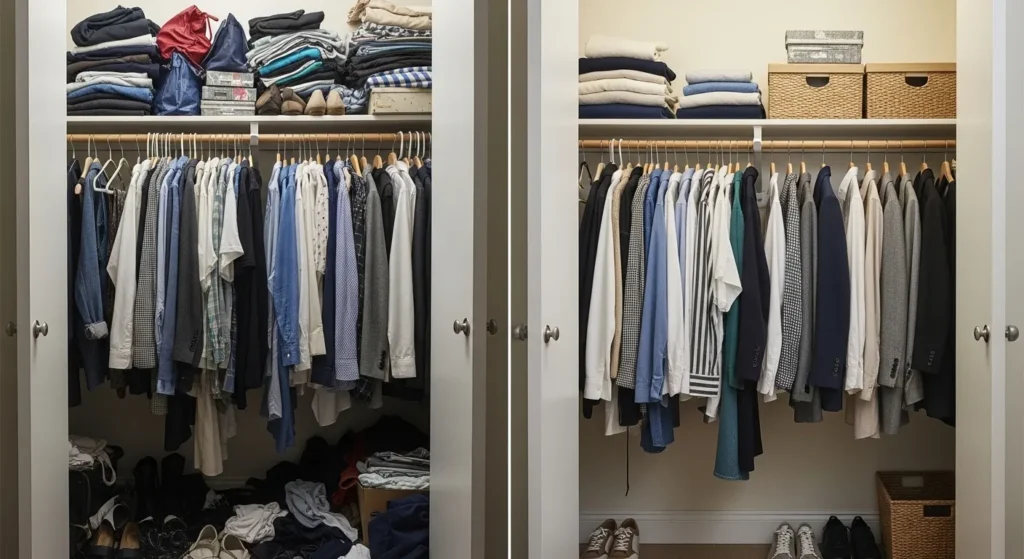
Maximize Vertical Space in Your Closet
Most small closets waste valuable vertical space above the hanging rod. Installing additional shelves or a second hanging rod can double your storage capacity.
Add a Second Hanging Rod
Install a second rod below your existing one for shorter items like shirts, skirts, and folded pants. This works best when your ceiling height is 8 feet or higher.
Use adjustable double rod attachments that don’t require drilling. These tension-based systems install in minutes and work in most closet configurations.
Install High Shelves
Add shelves 12-18 inches from the ceiling for storing seasonal items, luggage, or rarely used pieces. Use sturdy brackets that can support 30-40 pounds per shelf.
Keep frequently used items at eye level. Store heavy items on lower shelves to prevent accidents and make access easier.
Use Shelf Dividers
Wire or plastic shelf dividers prevent stacks of sweaters, jeans, and t-shirts from toppling over. They create defined sections that maintain neat organization over time.
Choose adjustable dividers that can accommodate different stack heights. This flexibility helps you adapt to changing wardrobe needs.
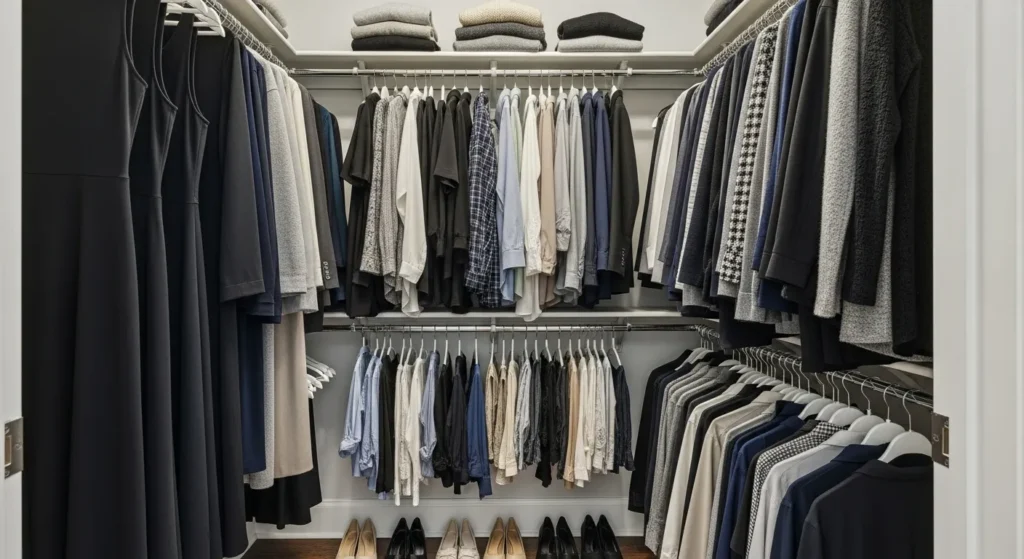
Door Storage Solutions That Add Instant Space
Closet doors offer hidden storage potential that most people ignore. Over-the-door organizers can hold shoes, accessories, and small clothing items without taking up floor space.
Shoe Organizers for More Than Shoes
Over-the-door shoe organizers with clear pockets work perfectly for storing rolled socks, underwear, belts, and small accessories. Each pocket provides easy visibility and access.
Choose organizers with 20-24 pockets for maximum storage. The clear plastic allows you to find items quickly without opening every pocket.
Install Door Hooks
Add hooks to the back of your closet door for tomorrow’s outfit, robes, or frequently worn jackets. Use heavy-duty hooks that can support 10-15 pounds each.
Position hooks at different heights to accommodate various garment lengths. This prevents items from bunching together at the bottom.
Towel Bars for Ties and Scarves
Install small towel bars on the door interior for hanging ties, scarves, and belts. This keeps these items visible and prevents them from getting tangled in drawers.
Use bars that are 12-16 inches long for optimal storage without overcrowding.
Smart Storage Solutions for Every Item Type
Different clothing items require different storage approaches. Organizing by item type creates a logical system that’s easy to maintain.
Shoe Storage That Saves Floor Space
Shoes take up valuable floor space in small closets. Vertical shoe storage solutions free up room for other items while keeping footwear organized.
Install a narrow shoe rack that fits between hanging clothes and the wall. Look for racks that are 6-8 inches deep to avoid interfering with hanging garments.
Use hanging shoe organizers with individual cubbies for dress shoes and heels. These protect shoe shape better than traditional shoe bags.
Store seasonal shoes in clear plastic containers on high shelves. Label containers with photos for easy identification.
Accessory Organization Systems
Small accessories like jewelry, belts, and scarves can create major clutter in limited space. Dedicated storage systems keep these items organized and easy to find.
Use drawer dividers or small containers for jewelry and watches. This prevents tangling and makes pieces easy to locate.
Install a belt rack on a side wall or door for easy access. Roll belts rather than folding to prevent creasing.
Create a scarf display using shower curtain rings attached to a hanger. This keeps scarves visible and wrinkle-free.
Handbag and Purse Storage
Store purses and handbags inside each other to save shelf space. Place smaller bags inside larger ones, with tissue paper to maintain shape.
Use shelf dividers to create individual slots for frequently used bags. This prevents bags from sliding around and becoming difficult to access.
Install hooks on closet walls for everyday bags you grab regularly. Keep these at eye level for quick access.
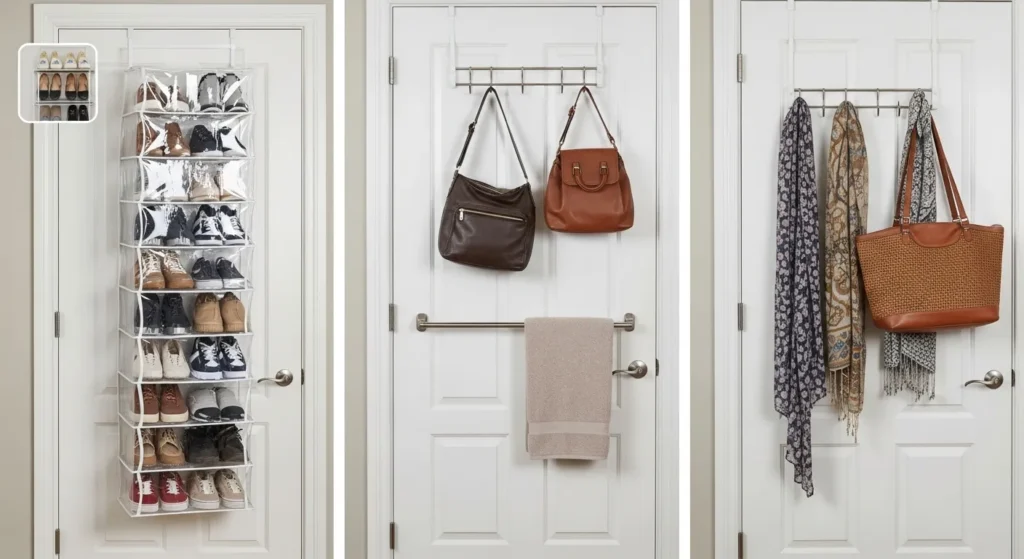
Seasonal Rotation Strategies
Small closets work best when they only hold current season clothing. Rotating your wardrobe quarterly creates more space and makes daily outfit selection easier.
Winter Storage Solutions
Pack away summer clothes in vacuum storage bags during cold months. These bags compress items to 75% less space while protecting from dust and moisture.
Store compressed bags under beds, in hall closets, or on high closet shelves. Label bags with contents and storage date for easy identification.
Use garment bags for delicate summer pieces that shouldn’t be compressed. Hang these in a secondary closet or storage area.
Summer Storage Systems
Winter coats and heavy sweaters take up enormous space during warm months. Store these bulky items in breathable garment bags or cedar containers.
Keep one light jacket accessible for air conditioning or cool evenings. Store the rest in containers with cedar blocks to prevent moth damage.
Rotate boots and winter shoes to under-bed storage. Keep only warm weather footwear in your main closet space.
DIY Organization Hacks That Cost Almost Nothing
You don’t need expensive closet systems to create better organization. These DIY solutions use common household items to solve storage problems.
Soda Can Tab Hack
Remove tabs from soda cans and thread them through hangers to create cascading storage. This allows you to hang multiple garments from a single hanger position.
This hack works best for thin items like camisoles, tank tops, or lightweight blouses. It can free up 50% more hanging space.
Tension Rod Solutions
Install tension rods in unused corners or between walls for additional hanging space. These require no drilling and can be adjusted as needed.
Use thin tension rods for lightweight items like scarves or ties. Heavier rods work for pants or skirts.
Position tension rods at different heights to create custom storage zones for specific clothing types.
Plastic Chain Hanging System
Hang plastic chains from closet rods using S-hooks to create vertical hanging space. Attach individual hangers to chain links at different heights.
This system works well for items you wear frequently. It keeps clothes visible while using minimal horizontal rod space.
Paint chains to match your closet hardware for a more polished appearance.
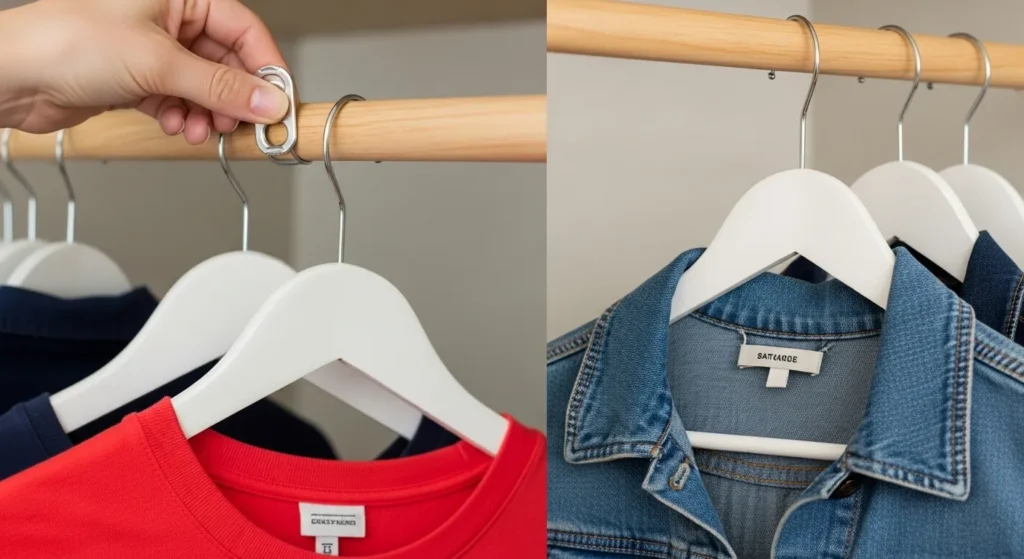
Organization Products That Actually Work
Not all closet organizers are created equal. These specific products solve real problems in small spaces without creating new ones.
Closet Systems Worth Buying
Modular wire shelving systems adapt to any closet shape and can be reconfigured as needs change. Look for systems with adjustable shelf heights.
Wood closet systems provide a custom look but cost more than wire options. Choose wood if you plan to stay in your home long-term.
Avoid systems that require professional installation unless you’re committed to a permanent solution. Most small closets work fine with DIY options.
Storage Containers That Save Space
Clear plastic bins allow you to see contents without opening containers. Choose stackable designs with secure lids for high shelf storage.
Fabric storage cubes work well for items you access frequently. They’re lighter than plastic and easier to move around.
Under-bed rolling containers make seasonal storage simple. Choose containers with wheels for easy access.
Hangers That Make a Difference
Slim velvet hangers use 50% less space than wire hangers while preventing clothes from slipping off. Replace all hangers with matching slim versions for immediate space gains.
Cascading hangers with multiple tiers work well for pants, skirts, or tank tops. These save horizontal rod space while keeping items visible.
Avoid bulky wooden hangers in small closets unless you have very few items. They take up too much precious rod space.
Specific Solutions for Common Small Closet Problems
Problem: No Room for Folded Clothes
Solution: Install a narrow dresser under hanging clothes or use hanging fabric organizers with multiple compartments.
Hanging organizers work well for t-shirts, workout clothes, and pajamas. They keep items folded and visible without requiring floor space.
Choose organizers with 6-8 compartments for optimal storage without overcrowding.
Problem: Shoes Everywhere
Solution: Use vertical shoe storage that takes advantage of wall space rather than floor space.
Over-the-door shoe organizers keep 12-24 pairs organized and visible. Clear pockets make finding the right pair quick and easy.
Narrow shoe racks that fit between hanging clothes and walls work well for frequently worn shoes.
Problem: Can’t Find Anything
Solution: Group similar items together and use consistent storage systems throughout the closet.
Keep all pants in one area, all shirts in another. This creates mental maps that make finding items automatic.
Use matching storage containers and hangers for a cohesive system that looks intentional rather than chaotic.
Maintenance Tips for Long-Term Success
Small closet organization requires ongoing maintenance to prevent returning to chaos. These habits keep your system working long-term.
Weekly Maintenance
Spend 10 minutes weekly returning items to their designated spots. This prevents small messes from becoming major reorganization projects.
Check for items that don’t belong in the closet and move them to appropriate locations immediately.
Monthly Reviews
Assess whether your current system still works for your lifestyle. Adjust storage locations for items you use more or less frequently.
Remove any clothing that’s been hanging unworn for the full month. These items likely need to find new homes.
Seasonal Overhauls
Complete seasonal clothing swaps ensure your closet only holds currently relevant items. This process typically takes 2-3 hours but saves daily frustration.
Use this time to clean closet surfaces and check for any needed repairs or improvements to your organization system.
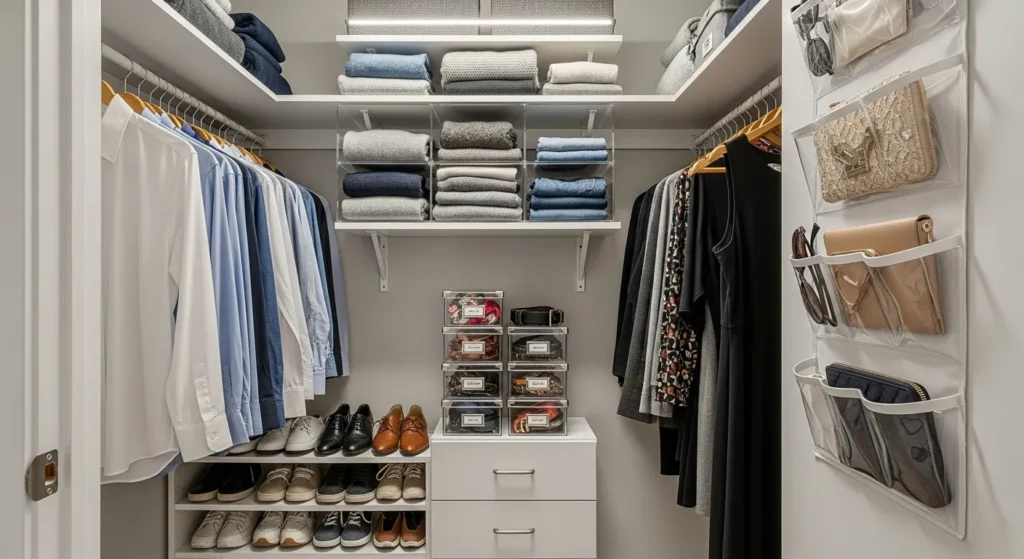
Measuring Your Space for Best Results
Before buying any organization products, measure your closet dimensions carefully. Width, depth, and height measurements help you choose products that actually fit.
Measure hanging rod height to determine if you have space for double rods. Most closets need 84 inches total height for effective double hanging.
Check door clearance to ensure over-the-door organizers won’t interfere with closing. Some doors need organizers that are 4 inches deep or less.
Measure shelf depth to choose appropriate storage containers. Standard closet shelves are typically 12-16 inches deep.
Budget-Friendly Organization Timeline
You don’t need to organize your entire closet in one expensive shopping trip. This timeline spreads costs while building an effective system.
Week 1: Purge and clean your closet completely. This costs nothing but creates immediate improvement.
Week 2: Add one key organization element like a second hanging rod or over-the-door shoe organizer. Budget: $15-25.
Week 3: Install shelf dividers and add storage containers for accessories. Budget: $20-30.
Week 4: Complete the system with any remaining storage solutions based on how the new organization is working. Budget: $15-40.
Conclusion
Small closet organization success comes from using every available inch while keeping systems simple enough to maintain. Start with decluttering, then add organization solutions one at a time.
The best small closet system is one you’ll actually use daily. Choose solutions that fit your lifestyle and budget rather than trying to create a picture-perfect magazine closet.
Remember that organization is an ongoing process, not a one-time project. Regular maintenance keeps your system working effectively year after year.
For more home organization tips, check out our guides on removing stubborn stains and choosing eco-friendly cleaning products to keep your newly organized wardrobe in perfect condition.
